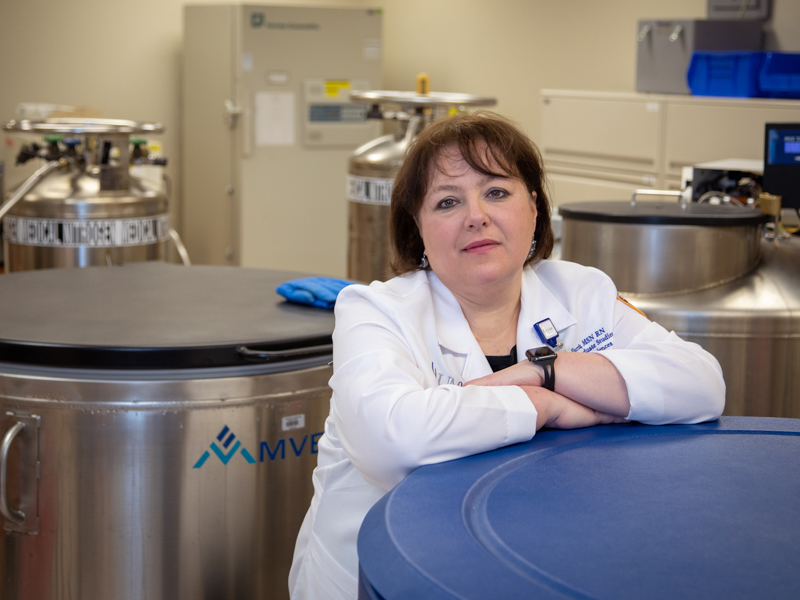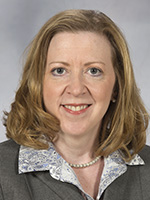#UMMCGrad2020: UMMC employee graduates with long-awaited degree

Pam Farris of Brookhaven is no stranger to overcoming obstacles.
After eight years working on her Ph.D. in nursing, she has successfully defended her dissertation and will graduate this year.
Farris has been employed at the University of Mississippi Medical Center for 26 years and received her bachelor’s, master’s and now doctoral degrees here. She currently works as the nurse manager of several areas: adult and pediatrics bone marrow transplant, marrow-transplant program, apheresis nursing, chemotherapy nursing and the bone marrow transplant lab.
“I’ve drunk the kool-aid,” she laughs, referring to her long-time commitment to UMMC.
While completing a Ph.D. and dissertation is not a fast or easy task for most, Farris faced extra challenges along the way. She contracted Lyme disease in 2001, and it remained undiagnosed until four years later – creating a snowstorm of added health issues and false diagnoses, including multiple sclerosis and lupus.
She incurred a spinal cord injury after contracting the disease, and her immune system has been dysfunctional ever since. Physical activity, even walking, can be extremely difficult for her.

She had a major fall in 2017 where she broke her lower leg and ankle, and it took her over a year to be able to walk again, but she persevered.
“It’s taken me since 2012 to finish my dissertation because of all those things that have happened,” she said. “I’ve had so many medical issues, and I’m always tired and not feeling well.”
What kept her going was her passion for her research and for improving her patients’ care.
“I need to do this for myself, and I wanted to make sure this research I felt so strongly about was finished,” she said.
She has been in her field long enough to see medicines and treatments of patients change and improve. She knew she wanted to be a part of improving patient care, which is why she decided to get her Ph.D.
After more than two decades of working with patients who received bone marrow transplants, she had a question: how would increasing their mobility by working with an exercise physiologist impact things like length of stay in the hospital, white blood cell counts and survival rates?
This became the question driving her research.
“Keeping patients moving seems to be the first thing that falls off (amid all the other tasks of a nurse), and we were sending everybody to rehab and they weren’t going home after their transplant because they were too weak to stand up,” she explained.
Her research looked at bone marrow transplant patients admitted to the Medical Center’s unit from 2012 to 2019, and the results were significant: the patients’ length of stay in the hospital was shortened by 1.62 days.
“It’s a huge economic factor – that’s thousands and thousands of dollars for UMMC that we didn’t spend,” she said.
There were also positive results for survival rates at 100 days and one year.

True to Farris’ constant desire to learn more, her research led her to ask even more questions about how more individualized nursing and multi-disciplinary interventions involving physical activity would impact bone marrow transplant patients. Her research also informs next steps regarding physical assessments of patients before their transplants to ensure their readiness for the very taxing procedure.
“There are always new and better things (for cancer and bone marrow patient care) to do every day, so you have to constantly be looking for those,” she said.
Farris’ desire to continually improve care for patients is well-known to those who work with her.
“She treats every patient as if they were family. She lives on a path of a continual pursuit of the best possible care and outcomes for her patients,” said Lee Ann Lutken, critical care tower nursing director, who has known Farris for 10 years and worked closely with her the past four.
Not only does Farris embody those values, but she imparts them to her employees as well, Lutken said.
“She has modeled the behavior and instilled in her staff that same passion for the best all-around care possible,” she said. “She’s created a legacy that will be revered for years to come.”
Farris believes in the power of mentorship, and she said even though it means she’s constantly going through the hiring process, she always encourages her employees to achieve more.
“I’m very strong in my opinion about the importance of mentorship. I want you to get your degree, and I will always try to do what I can to help your schedule so you can meet your goals,” Farris said of how she helps her staff continue growing as nurses.

Dr. Mary Stewart, director of the Ph.D. program and chair of Farris’ dissertation committee, has known Farris since her days with the Mississippi Nurses Association where she served as president from 2005 to 2009.
“Pam is a ‘nurse’s nurse.’ From leading the Mississippi Nurses Association, serving on the board of directors of the School of Nursing Alumni Association and engaging on the national level with the Oncology Nurses Society, Pam’s greatest contribution remains her daily commitment as a role model to other nurses,” said Stewart. “Pam is a real person to real nurses, and she embraces the value of unique contributions of nursing research to improve care for patients with cancer.”
She has “constantly dedicated herself and challenged her employees to understand and use good research to ensure evidence-based practice remains paramount.”
Stewart said she has no doubt that Pam’s work will continue to benefit other nurses and patients, specifically those in the world of bone marrow transplant.


